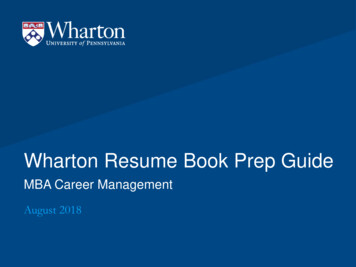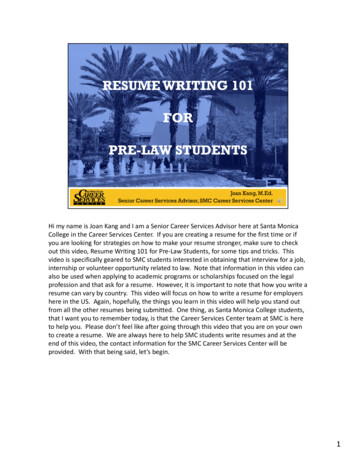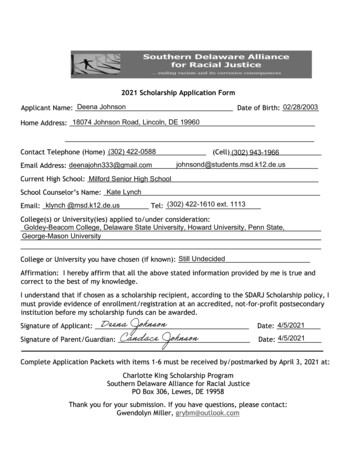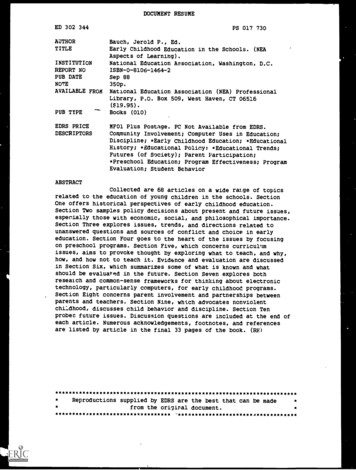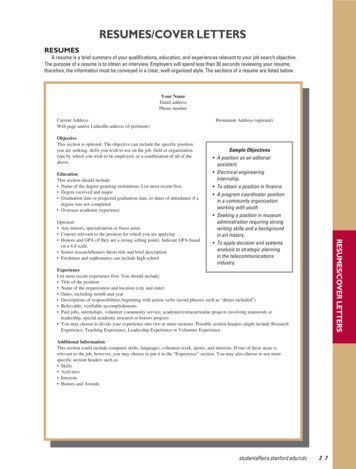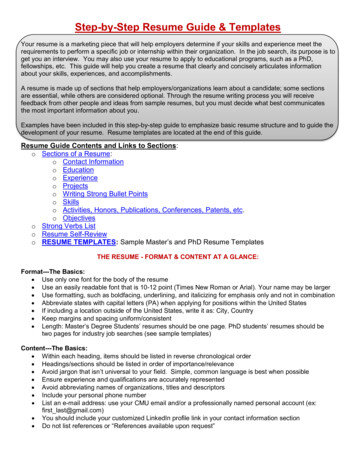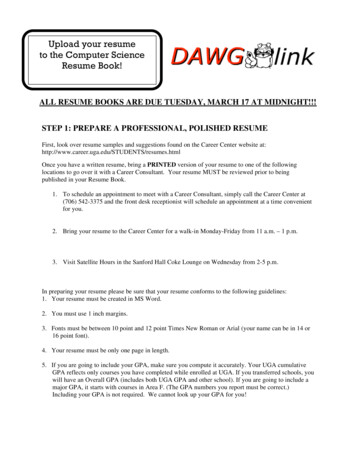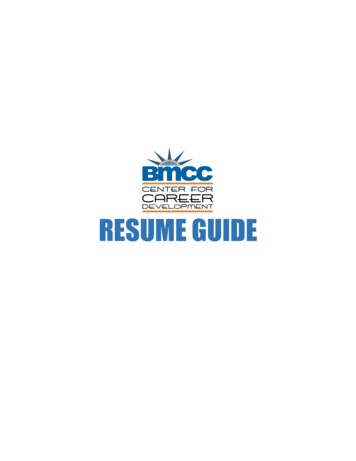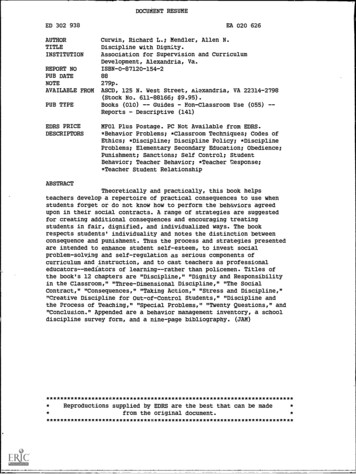
Transcription
DOCUMENT RESUMEED 302 938AUTHORTITLEINSTITUTIONREPORT NOPUB DATENOTEAVAILABLE FROMPUB TYPEEDRS PRICEDESCRIPTORSEA 020 626Curwin, Richard L.; Mendler, Allen N.Discipline with Dignity.Association for Supervision and CurriculumDevelopment, Alexandria, Va.ISBN-0-87120-154-288279p.ASCD, 125 N. West Street, Alexandria, VA 22314-2798(Stock No. 611-88166; 9.95).Books (010) -- Guides - }on- Classroom Use (055) -Reports - Descriptive (141)MF01 Plus Postage. PC Not Available from EDRS.*Behavior Problems; *Classroom Techniques; Codes ofEthics; *Discipline; Discipline Policy; *DisciplineProblems; Elementary Secondary Education; Obedience;Punishment; Sanctions; Self Control; StudentBehavior; Teacher Behavior; *Teacher ' response;*Teacher Student RelationshipABSTRACTTheoretically and practically, this book helpsteachers develop a repertoire of practical consequences to use whenstudents forget or do not know how to perform the behaviors agreedupon in their social contracts. A range of strategies are suggestedfor creating additional consequences and encouraging treatingstudents in fair, dignified, and individualized ways. The bookrespects students' individuality and notes the distinction betweenconsequence and punishment. Thus the process and strategies presentedare intended to enhance student self-esteem, to invest socialproblem-solving and self-regulation as serious components ofcurriculum and instruction, and to cast teachers as professionaleducators--mediators of learning--rather than policemen. Titles ofthe book's 12 chapters are "Discipline," "Dignity and Responsibilityin the Classroom," "Three-Dimensional Discipline," "The SocialContract," "Consequences," "Taking Action," "Stress and Discipline,""Creative Discipline for Out-of-Control Students," "Discipline andthe Process of Teaching," "Special Problems," "Twenty Questions," and"Conclusion." Appended are a behavior management inventory, a schooldiscipline survey form, and a nine-page bibliography. *******************X******Reproductions supplied by EDRS are the best that can be madefrom the original ******************************
L fllemoiwith D .[LirirArRichard L. Curwinand Allen N. Mendler4111PilmnAM IMMO lowAssociation for Supervision and Curriculum Development3
To lily wife Barbara fur her love and friendship and sharing in the dailychallenge of parenting, and to my wonderful sons Jason and Brian, whoselove and achievements affirm the virtue of raising diddle', with dignity andrespect.Allen MoldierFor no. mother Ann for a lifetime of support and love, who taught are the truemeaning of dignity, and for three of hem grandchildrenDavid, Andy, andDanny Cumin to whom I hope to teach the same.Rick Cumin
Whose school is this, anyway?Is it the principal's?Is it the teachers'?Is it the smart kids'?Is it the shy kids'?Is it the pushy kids'?Is it the popular kids'?Is it each kid's equally?Is it the kids', the principal's, and the teachers' equally?Who decides what goes on in here?Who does it go on for?Does it go on for the kids who go to college?Does it go on for the kids who go to work?Does it go on for the kids who have nowhere to go?Does it go on for all kids equally?Does it go on for the teachers?Does it go on for the principal?Does it go on for the teachers, the kids, and theprincipal equally?Who tells whom what to do?Who makes the rules?Who are the rules for?Who must follow the rules?Who must see that the rules are followed?Whose school is this, anyway?5
Richard Curwin is an assistant professor of education at San Francisco State University. He has been a junior high school teacher andhas conducted workshops for ASCD for 15 years. He is also the authorof Discovering Your Teaching Self.Allen Mendler is a school psychologist and a psychoeducational consultant in Rochester, N.Y. He has worked extensively with childrenand teachers at all grade levels and among special needs populations.Curwin and Mendler have coauthored two earlier books on discipline.Copyright 1988 by the Association for Super. ision and Curriculum Development.All rights reserved. No part of this publication may be reproduced of transmitted in any form or by any means, electronic or mechanical, includingphotography, recording, or any information storage and retrieval system,without permission in writing from the publisher.ASCD publications present a variety of viewpoints. The views expressed orimplied in this publication are not necessarily official positions of the Association.Typeset by Scott PhotographicsPrinted by Edwards Brothers, Inc.ASCD Stock Number: 611-88166Library of Congress Cataloging-in-Publication DataCumin, Richard L., 1944 Discipline with dignity/Richard L. Curwin and Allen N. Mendler.p.cm.Rev. ed. of: Taking charge in the classroom/Allen N. Mendler,Richard L. Cumin.Curwin's name appears first on the earlier edition.Bibliography: p.ISBN 0-87120-154-2I. School discipline. 2. Classroom management. 1. Mendler,Allen N. II. Mendlcr, Allen N. Taking charge in the classroom.Ill. Title.I.B3011.C887 1988371.1 '024 dc19Price: 9.9588-39922
Discipline with DignityAcknowledgmentsForeword1. Disciplineviviii12. Dignity and Responsibility in the Classroom203. Three-Dimensional Discipline324. The Social Contract5. Consequences6. Taking Action7. Stress and Discipline8. Creative Discipline for Out-of-Control Students9. Discipline and the Process of Teaching10. Special Problems11. Twenty Questions22512. Conclusion241Appendix A: Behavior Management Inventory242Appendix B: School Discipline Survey247Bibliography259476594113135159182
AcknowledgmentsWhen the Association for Supervision and Curriculum Devel-opment asked us to revise our book Taking Charge in theClassroom,' we were both professionally and personallydelighted. The personal joy came from the opportunity towork together once again as friends and colleagues on a project thatis just as relevant today as it was when we first began our work indiscipline 10 years ago. Professionally, it provided us an opportunityto apply what we had learned since we wrote Taking Charge in 1983.This new version, Discipline with Dignity, is significantly different.Some of our earlier thoughts no longer seem as valid, and many newideas, principles, concepts, and strategies have been added.Significantly, we see the need for "disciplining with dignity" aseven greater now. School staff members seem to feel the need to gettougher, to send the message that misbehavior will no longer be tol-erated. The fabric of society is changing rapidly. This changesignificantly affects children, and the schools are having troublekeeping up. Changes in the family, in early child education, in thedemands that society has placed on the schools, and the information1 Allen Mend ler and Richard Curwin, s1983.i. Taking Charge in the Clawoom (Reston. Va. Reston PublishingCo.),vi
DISCIPLINE WITH DIGNITYexpiosion have all made a powerful impact on the way students perceive school and their role as learners.Now, more than ever, we must take a good look at what we areteaching our children by the way we treat them. Controlling theirbehavior is simply not enough. We must help them become decisionmakers and critical thinkers. We must help them feel that they cancontribute to society, and we must enhance their joy for learning.Discipline with Dignity was written to achieve these goals.We wish to thank the following individuals for their assistance,support, insights, and encouragement: Ron Brandt, Raymond Wlodkowski, Millie Ness, Marian Leibowitz, Alan Fibish, Bernard Palmer,Betty Osta, Pat Bourcy, Jake Clockedile, the teachers and administrators at Tam High School in Mill Valley, California, Jefferson HighSchool and Westmoor High School in Daily City, California, OceanaHigh School and Terra Nova High School in Pacifica, California,Nancy Modrak, Rene Townsley, and the ASCD staff, and the manyparticipants in ASCD conferences and NCSIs who have asked manydifficult questions and added many suggestions, refinements, and onsite validation.RICIIARD CUMINALLEN MENDLERvii
ForewordSchool staffs searching for ways to enhance their discipline prac-tices will find this book filled with practical, tested, andworthwhile school and classroom techniques. Working together,parents, administrators, and teachers of all grade levels andsubject areas can develop a common agreement on ways to handlebehavior problems in a manner that helps students consider their ownactions, examine rational consequences, and decide for themselveswhich results they will choose.The guidelines Curwin and Mend ler offer can help teachersdevelop a repertoire of practical consequences to use when studentsforget or don't know how to perform the behaviors agreed upon intheir social contracts. They suggest a range of strategies for creatingadditional consequences and encourage treating students in fair andindividualized ways.Curwin and Mend ler respect students' individuality and makean eloquent distinction between consequences and punishment.Thus, the processes and strategies presented at e intended to enhancestudent self-esteem, to invest social problem solving and self-regulation as serious components of curriculum and instruction, and tocast teachers as professional educatorsrather than policemen.viii1.10mediators of leathing
}1101111 DISCIPLINE win' DIGNITYDiscipline With Dignity implies not only dignity for the studentbut for the teacher as well. Not only do both parties enter and leavea problem situation with their dignity enhanced, but the process theyengage in dignifies the problem itself. Thus, learning how to behavein responsible ways is accomplished not only in the context of class-room life, but is applied to social problem solving in other lifesituations as well.We are increasingly aware of the demands of living in a futuresociety in which compassion and cooperation, problem solving andcreativity, and communications and internal responsibility will beparamount. Curwin and Mend ler have given yet another means ofaligning our discipline policies and procedures with those larger,long-range educational outcomes.I strongly urge educators to consider the theoretical and practicalsuggestions presented here, to test their %aliclity in each community,school, and classroom setting, to gather e% idence of tilt:it effects overtime, and to generate additional discipline strategies consistent IS it hthis philosophy.ARTI RJR L. CosiASCD President,1988-89ix
IDiscipline1907, William Chandler Bagley of the University of Illinoiswrote, "Absolute fearlessness is the first essential fin the teacheton whom rests the lesponsibility for go% el ning an elemental y orsecondary school. This fearlessness is not alone or chiefly theexpression of physical courage, although this must not be lacking. Itis ratho an expression of moral courage, daring the sometimes certain interference of pat cnts, officious ti ustccs [achni,.;sti awl s] andInothers of like character, standing firm in one's on fictions eventhough the community may not approve. And, after all, it is this an tof courage that is the rarest and, at the same time, the most essential.'iIn 1988, Heathel D. Osborn, a high school senior from Houston,Texas, wrote the following N.-in about het expel loxes in school.Silent DefianceI'm the one who watched,As you laughed;I'm the one who listened patiently,While you talked unceasingly;I'm the one who sat silent,As your shouts grew louder,12
DISCIPLINE NVITH DIGNITYI'm the one who always came,While your chair sat empty;I'm the one whose dreams were hidden,as yours were fulfilled;I'm the one who cared,while you butchered knowledge;I'm the one who watched your petty warsover something you couldn't understand;I'm the one who reasoned,as you discussed,I'm the one who will rememberwhen all of you will forget.Dedicated to Laurawho understood.For at least the eight decades between the writings of Dr. Bagleyand Heather, teachers and students have needed courage to face eachother. School is a battleground for too many participants, a placewhere major confrontations and minor skirmishes occur daily. Whymust this be so? Teachers and students share the same space, time,goals, and needs. They spend most of the day communicating witheach other, thinking about each other, scheming against each other,and judging each other. When they are antagonistic, they expend asmuch if not more time and energy trying to outsmart each other andwin, or at least achieve a standoff. If things get bad enough, theyhave the power to ruin each others' lives. When things go well, theyshare tender moments, meaningful triumphs, and genuine respectand love. Regardless of how it goes, teachers and students neverforget each other.We contend that it is essential to replace competitive metaphorsin schools with new images of cooperation, mutual respect, and commitment to common goals for the good of everyone in the classroom.Courage must always be a part of the learning process, but we prefercourage to be used to explore new worlds or to make meaningfulchanges in perceptions and behaviors.For most teachers and students, a main battlefield revolvesaround discipline. Much has been written about discipline over theyears, and many programs and methods have been tried and retriedwith new names. The issue will always be an integral part of schoolbecause students will always learn more than the content of the curriculum. They will learn about their behavior, their choices, and their213
DISCIPLINEimpact on others. Instead of trying to solve the discipline problem, itmight be wiser to try to positively affect the lives of children. Westrongly advocate a model of discipline based on a positive valuesystem and suggest many practical methods to implement such asystem in the classroom. One of our goals is for all the suggestionsin this book to be consistent with what we believe to be best forchildren.In this book you will learn strategies for developing a philosophyabout behavior management based on sound educational, psychological, and commonsense principles:Developing a comprehensive classroom discipline plan.Stopping misbehavior when it occurs without attacking thedignity of the student.Resolving problems with students who chronically disrupt thelea: ing process.Reducing student stress as well as your own.Using special guidelines for rules and consequences that work.Few woula argue that maintaining goo(' discipline is a necessaryprecondition to establishing a school or classroom climate that isconducive to learning. James Coleman, the controversial Universityof Chicago sociologist, recently studied the effects of private versuspublic school education. After surveying 58,728 sophomores andseniors in 1,016 high schools, he concluded that private schools do abatcr job of educating than public schools.' Coleman pointed to theability of private schools to maintain better discipline and providemore challenging academic demands. He found that public schoolsophomores appear twice as likely to disobey, fight, or commit acts ofvandalism than their private school counterparts.While one may question Coleman's ability in light of his 1966study, which found that schools make little difference in educatingstudents, it is unlikely that contemporary educators will argue againstthe notion that discipline problems in schools throughout Americaare on the rise in scope and intensity.The many problems in schools today can generally be categorized with out-of-school or in-school causes. In discussing today'sstudent, Dillon notes:Teachers today are working with a different kind of student. Parents more and more frequently admit that theycannot control their children. Many even abandon them.Many students act as free agents. They do not live at home
r--DISCIPLINE WITH DIGNITYand are responsible to no one. They have few personalrestraints. The number of students placed on permanent suspension from school for misbehavior ormaladjustment is increasing. The age of those being suspended is decreasing. Growing numbers of elementarystudents are out of school because they are disruptive to theteaching-learning process. The growing clarity of studentrights and due process has taken away traditional disciplinestrategies in which many teachers found security; and manyteachers are without skills to replace them?In schools that "care:' it is common for a disruptive student tobe referred to guidance, mental health, and administrative resourcesfor an evaluation. Following the evaluation, a conference is called toinform the teacher about the student's background, home situation,test results, and other descriptive information. The teacher alreadyknows most of this information, but using it to take concrete andspecific action is rare. The teacher, while filled with empathy, oftenfeels incapable of responding differently because he views these recommendations as not feasible for a regular class setting. But he doesnot want to appear rigid and uncaring, so he simply nods his headin agreement with the recommendations and proceeds to do the besthe can.Psychologists or social workers, well-trained in counseling, areoften unavailable for needed intervention because of their limitedtime and excessive caseloads in most schools. Instead they meet withthe child's parents, suggest the need for individual or family coun-seling at the lecal child guidance clinic, aad write their reports;perhaps 9 times out of 10, no further action ensues. The administrator, wanting to support the teacher, makes himself available for crises,which occur with frequency, and often elicits a series of temporarypromises from the student to try harder and behave better. Theoverall effects of this process: a lot of understanding and very littlechange!Much of this book addresses what can be done about disciplineproblems, but it is first necessary to consider those factors responsiblefor the alienation experienced by too many youths in schools. Thecauses of discipline problems are discussed briefly because it is ourbelief that schools waste far too much time and energy trying tounderstand why students misbehave when they should be trying tochange their pattern of misbehavior.
DISCIPLINESchools do not exist as isolated institutions untouched by thesocial events surrounding them. Schools are both a mirror image ofwhat transpires in their communities and a force that attempts toconvey and shape the values, beliefs, and attitudes of students. Beingboth a mirror image and a dynamic force makes it essential that weunderstand how factors that occur both within and outside theboundaries of schools interact to create discipline problems. 011ie thecontext is understood, teachers can learn how to act upon thosefactors that are within their control and how to live with those thatare not.Out-of-School Causes of Discipline ProblemsViolence in SocietyWithout belaboring the social ills of our world, the fact is thatwe live in a society where resolving problems through shootings,knifings, fist fights, extortion, and threats of injury is commonplace.Every day we pick up the newspaper and learn of another violentdeath. People's inhumanity to one another is not news. Children areconstantly exposed to violence and have become insensitive to it.Shortly after the assassination attempt on President Reagan, we inter-viewed school-age children to learn of their reaction. We wereastounded by the near absence of emotion to the event. That absenceof shock is a sad commentary on how easily we seem to accept violenceas a natural way of life.Effects of the MediaTelevision has often been blamed, with justification, for theincrease in violence among children. We recently noted at least 50acts of violence during a half-hour broadcast of a well-known, dailycartoon show. Try observing children's television and notice how themost popular shows glamorize and glorify anti-authority protagonistsas they behave irresponsibly.A recent study that reviewed a decade of research concerningtelevision and 'youth concluded that children will have viewed approx-imately 18,000 acts of television violence by the time they enteradolescence.' Although it is impossible to know the full extent of theinfluence of standard programming, we believe that television andother media have a potentially damaging effect on children. And kidswith special needs seem particularly at risk. Sprafkin, Kelly, andGadow (1987) found that emotionally and learning-disabled children516
DISCIPLINE WITH DIGNITYare less able to distinguish between fantasy and reality on televisionprograms and commercials.5In Media Sexploitation (1976) and Subliminal Seduction (1973), Wil-son Bryant Key points out how violent and sexual messages areimplicitly and explicitly built into television and print advertisements.His studies show that people become agitated when confronted withthese messages, which are really selling sex, death, and violence."Me" GenerationThe absence of emotional nourishment for many of our children,in a nation still reeling from the values permeated by what Christopher Lasch calls the "me generation;' is another external cause ofschool discipline problems. We have become a throw-away societythat discards husbands, wives, children, and things. Rightly orwrongly, many people seek refuge from unhappiness and depressionin ways that leave little time and commitment for their children.Recent statistics have suggested that between 35 and 50 percentof all school-age children will experience significant shifts in theirfamily constellation before they complete school.' Twelve of 100 chil-dren in 1986 were born to unmarried parents, 40 were born toparents who will divorce before the child is 18, 5 have parents whowill separate, and 2 have parents who will die. In all, only 41 percentwill reach their 18th birthday in "traditional" family units.It is no secret, therefore, that many students come to school moreconcerned for their basic security needs than for learning their timestables. The loss of reliance upon parents for basic security has createda large group of children who are desperate for help in healthyemotional development. Many students have adopted the me-gener-ation attitude of, "Meet my needs first. I do not intend to wait. Icome first:'Lack of a Secure Family EnvironmentPerhaps the largest single influence on children is the quality oftheir home life. Throughout the last century, our society has undergone major shifts in values and traditions. The extended family hasbeen replaced by smaller nuclear units in a multitude of configurations. Single-parent families, two working-parent families, and oneand two-child families are all common. The divorce rate has steadilyrisen so that some states have more divorces than marriages. Allthose changes, while neither good nor bad in themselves, have madeit increasingly difficult to raise children in the traditional ways. And617,,
DISCIPLINEbecause we have not been as successful in developing family systemsthat match these shifting life styles, many parents have no newoptions for providing a secure family structure.Much research shows that how parents respond to their child'smisbehavior has major consequences for the child's future development. For example, Holmes and Robbins (1987) found that unfair,inconsistent, and harsh discipline by parents predicted later alcoholand depressive disorders.' Self-concepts are first developed and moststrongly influenced in the home, and parents need to learn moreskills for helping children develop amid constantly shifting familypatterns.Difficult TemperamentSome recent studies (Maziade et al. 1986) have found children'stemperaments to be more "plastic" than formerly believed. Particularly at the extreme ends of the continuum, children who are veryeasy or very difficult to deal with are likely to remain that way foryears. Clearly, some children a. e difficult to manage despite adequateparenting and relative absence of all the psychosocial factors alreadymentioned. But parents can influence such children to change in"desirable" ways when a firm, consistent, and loving approach todiscipline is offered.In-School Causes of Discipline ProblemsStudent BoredomTeachers have spent many years accumulating a body of knowledge that they value, and they are excited with heir work when theyfeel their students are enthusiastic about what is being offered.Nobody wants to have students in class who appear uninterested, donot participate, and do not do their assignments.Some students do not present themselves as discipline problemsbecause they have developed good classroom etiquette. Ti-.-y sit upstraight, appear attentive by making eye contact, nod their headsevery so often, and present themselves as interested and somewhatinvolved, even when they are downright bored. But there are somestudents who don't have (or won't develop) these survival skills.Instead they act out to satisfy their needs. They have no desire tohide their boredom, acid they appear unconcerned with the consequences of poor grades, a trip to the principal's office, or a phonecall home. Most teachers feel fed up and angry with such students,718
DISCIPLINE WITH DIGNITYand they view them as a waste of their time. Such students derivepleasure from making the teacher angry, and their teachers derive ameasure of satisfaction in catching them being "bad:' When thisinteraction continues, conflict ensues. The teacher will often resort,consciously or not, to labeling the student negatively, and the studentwill then accuse the teacher of picking on him unjustly. A disciplineproblem has occurred, and both are responsible!PowerlessnessPowerlessness is another factor in school and classroom disciplineproblems. Some students rebel as a way of voicing their dissatisfactionwith their lack of power. In most schools, students are told for sixhours every day where to go, what time to be there, how long to takefor basic biological necessities, which learning is relevant, what tolearn, and how their learning will be evaluated. These decisions areoften made by the local school board or by the school administrationin consultation with members of the school community. Student participation in decision making is often excluded. The result is that onegroup develops rules and procedures that define behavioral stan-dards for another group that has had little or no input. More thanone revolution has been precipitated by a similar division of power.Schools that exclude students from school or classroom policy-making committees run a major risk of widespread dissatisfaction withrules that are perceived as arbitrary and unfair. Students show theirdissatisfaction by acting out when they perceive themselves as havingno say in how the classroom is run. "Powerless" students have morepower than many school personnel give them credit for, and manystudents are more than willing to show just how much power theyreally have.Unclear LimitsAt the very least, teachers and administrators must clearly andspecifically inform students of the standards of acceptable behaviorbefore they are violated and what will happen when these standards areviolated. At best, students are often presented with unclear rules andless clear consequences. In most schools, students are unwittinglyencouraged to break rules because they are not informed of them inadvance. When limits are unclear, students will test the system to findout what they are. The following case illustrates the necessity forclear rules and consequences.19 ,.8
DISCIPLINEA junior high school we recently worked with was having aproblem with student fighting. We discovered that a no-fighting ruleexisted in the student handbook, but no mention was made of consequences. An interview with the principal revealed that the actual,unwritten consequences ranged from teachers not even referring thestudent, to a talk with the student, to a one-day suspension. Becausefighting had become a serious problem, we suggested an immediate,short-term solution to the problema solution that reveals one of ourbiases. We met with faculty members, and they agreed that anystudent who fought on school grounds would be suspended from oneto five days, depending on the severity of the infraction. The studentwould not be allowed to return to school until he had developed awritten plan for how he would behave if the circumstance happenedagain. In addition, a parent conference was mandatory before thestudent could return to school.The principal was initially uncomfortable with the recommen-dation because he believed that suspension was an ineffectiveresponse to student misbehavior. He believed it would not help togive the offender a sanctioned vacation. We believed that if all teach-ers agreed on the procedure, it was worth trying. Furthermore, wefelt that all students (and teachers) have a right to attend schoolwithout concern for their own safety. If people are fearful, theirability to learn (and to teach) is adversely affected. If a studentchooses to fight, then he is violating the safety rights of others and ischoosing to be temporarily excluded from school.Feeling desperate, the principal reluctantly agreed to try theplan. He next met with every faculty team, and they presented theplan to the students. In short, the principal specified the rule, solicitedsupport from his staff members, and told students in advance whatwould happen if fighting occurred. Fighting increased during thefirst few days after the plan was implemented. But after one week,the incidence of fighting dropped to near zero. Students needed totest the rule, and when they found out that the rule would be strictlyenforced, they stopped.Lack of Acceptable Outlets for FeelingsAnother source of discipline problems is the lack of acceptableoutlets for expressing feelings. Don't run. Don't fight. Don't throwfood. Most teachers have rules so stud
1. Discipline 1 2. Dignity and Responsibility in the Classroom 20 3. Three-Dimensional Discipline 32 4. The Social Contract 47 5. Consequences 65 6. Taking Action 94 7. Stress and Discipline 113 8. Creative Discipline for Out-of-Control Students 135 9. Discipline and the Process of Teaching



